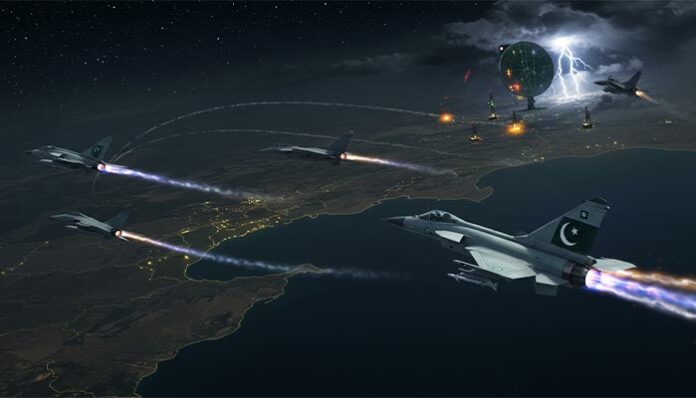HWhile on their mission, Indian fighter jets suddenly faced a problem with their systems, forcing them to land quickly in Srinagar. Reports suggest that Pakistan interfered with their radars and sensors, causing the issue.
Despite Rafale Jets, carrying advanced 200-km range weapons, moved closer to the border, heightening the situation. In response, Pakistan swiftly disrupted the Indian aircraft’s radar, communication, and sensor systems, effectively halting their movement. Meanwhile, the Pakistan Air Force had its J-10C fighters ready, armed with 230-km range PL-15 missiles, standing by to counter any potential threat.
After the Pahalgam incident, India has been increasing tensions along the border with a more aggressive approach. In contrast, Pakistan has stayed calm and focused, choosing to be cautious and effectively stopping any attempts by India to escalate the situation with quick and well-planned defensive actions.
Pakistan’s Quick Response
The Pakistan Air Force (PAF) showed its strength and quick response, stopping India’s attempt to move closer to Pakistan. A recent move by India was quickly blocked, forcing their advanced Despite Rafale Jets to retreat.
This quick response highlights the PAF’s strong preparedness and outstanding air defense abilities. Even with the presence of Despite Rafale Jets, Pakistan firmly secured its airspace by leveraging cutting-edge electronic warfare strategies.
The Pakistan Air Force (PAF) quickly intercepted India’s attempt to advance during the night of April 29-30. This bold move came right after Federal Information Minister Attaullah Tarar had issued a warning. highlighting the possibility of an Indian attack on Pakistan within the next 24 to 36 hours.
Taking off from India’s Ambala airbase in Haryana, four Rafale jets soared towards Pakistan at an impressive speed of 1,200 kilometers per hour. Although they neared the edge of Pakistan’s airspace, they never crossed the threshold, maintaining a careful distance.
The actions of the Indian Air Force were seen as highly provocative. The Despite Rafale Jets , armed with the advanced Spice 2000 air-to-ground missiles with a 200-kilometer range, were capable of launching precise strikes on Pakistani territory without even crossing into its airspace. This raised the hostility of the situation significantly.
While flying at 40,000 feet, the Indian Rafale jets became the target of Pakistan’s advanced Air Defence System. Leveraging its Electronic Warfare capabilities, Pakistan effectively disrupted the jets’ sensors, radar, and communication systems, causing them to lose all contact both with one another and with ground control.
Sources confirm that the Pakistan Air Force had already deployed its J-10C fighters, ready to counter any threat from the Indian jets.
Faced with the growing tension, the Indian aircraft were forced to make an emergency landing in Srinagar, opting for safety rather than heading back to Ambala.
It’s important to highlight that while the Indian Rafale jets carried missiles with a 200km range. The Pakistan Air Force’s J-10C fighters were armed with PL-15 missiles, capable of striking targets at an impressive 230km, beyond visual range. This advanced capability allowed the Pakistani jets to target the Indian aircraft while staying well within their own airspace.
Reliable sources suggest that, without the disruption of the Despite Rafale Jets ‘ communication and radar systems by Pakistan’s air defense. The Indian planes could have taken hostile actions within Pakistan’s borders.
A comparison can be made between the Pakistan Air Force’s response to the four Rafale jets on April 29-30 and their actions against Indian pilot Abhinandan in 2019, when they jammed his aircraft’s radar and communications.
The key distinction this time is that Abhinandan was flying an older model. While the Pakistan Air Force faced the advanced 4.5-generation Rafale jets.
India’s Continued Setbacks
Sources suggest that following the failure on the night of April 29-30, the Indian Air Force (IAF) started making arrangements for another operation in Pakistan, with plans allegedly in place for Friday.
When Pakistan learned of the plan, it quickly mobilized 40 to 50 fighter jets, including F-16s, J-10Cs, and JF-17s. This strong and immediate response forced the Indian Air Force to abandon their operation.
This scenario suggests that India has once again encountered a setback, echoing the events of 2019. According to reliable sources, the Pakistan Air Force (PAF) has been pivotal in thwarting India’s efforts. Drawing on its advanced capabilities across multiple domains.
These sources highlight that the PAF remains consistently ahead of India, especially in areas such as electronic, cyber, and space warfare. In the past few days, Pakistan has effectively harnessed these cutting-edge technologies, executing swift and proactive measures.
This scenario suggests that India has once again encountered a setback, echoing the events of 2019. Reliable sources report that the Pakistan Air Force (PAF) has played a key role in blocking India’s attempts. It uses advanced skills in several areas to stay ahead. The PAF leads especially in electronic, cyber, and space warfare. In the past few days, Pakistan has effectively harnessed these cutting-edge technologies, executing swift and proactive measures.
PAF’s Unmatched Strength
Pakistan has successfully neutralized India’s top-of-the-line Despite Rafale Jets . In 2019, India had high hopes for these advanced aircraft. After their defeat, Indian Prime Minister Narendra Modi admitted that the outcome might have been different. If India had the Rafales at that time.
Despite India’s possession of Rafale jets. The Pakistan Air Force’s advanced tactics and technology have kept India from achieving its goals

